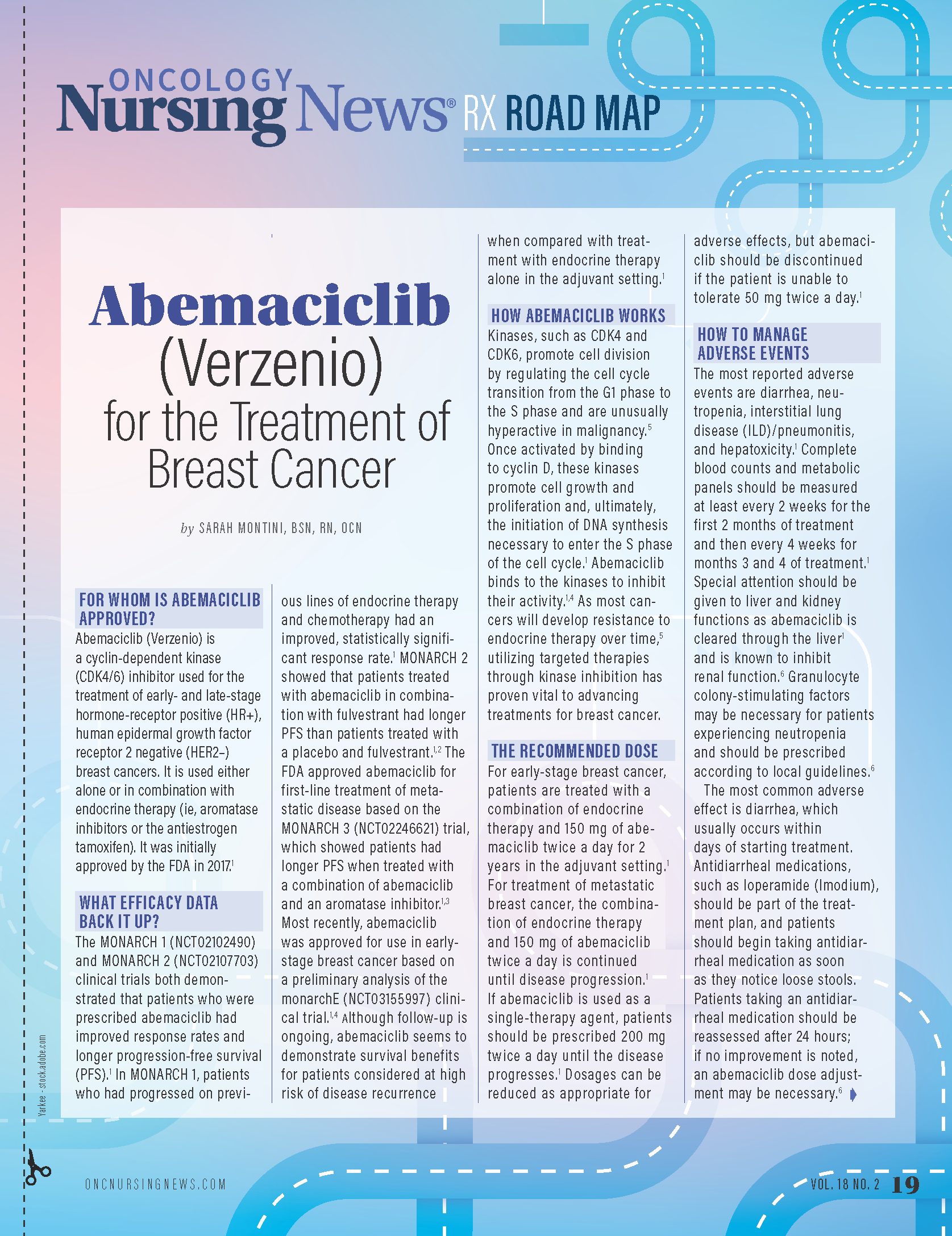Rx Road Map: Abemaciclib (Verzenio)
Sarah Montini, BSN, RN, OCN, provides an in-depth look at abemaciclib for the treatment of patients with breast cancer in a downloadable reference sheet.
Abemaciclib (Verzenio) for the Treatment of Breast Cancer

For a downloadable version that you can print at home, check out our Rx Road Map page.
For Whom Is Abemaciclib Approved?
Abemaciclib (Verzenio) is a cyclin-dependent kinase (CDK4/6) inhibitor used for the treatment of early- and late-stage hormone-receptor positive (HR+), human epidermal growth factor receptor 2 negative (HER2–) breast cancers. It is used either alone or in combination with endocrine therapy (ie, aromatase inhibitors or the antiestrogen tamoxifen). It was initially approved by the FDA in 2017.1
What Efficacy Data Back It Up?
The MONARCH 1 (NCT02102490) and MONARCH 2 (NCT02107703) clinical trials both demonstrated that patients who were prescribed abemaciclib had improved response rates and longer progression-free survival (PFS).1 In MONARCH 1, patients who had progressed on previous lines of endocrine therapy and chemotherapy had an improved, statistically significant response rate.1 MONARCH 2 showed that patients treated with abemaciclib in combination with fulvestrant had longer PFS than patients treated with a placebo and fulvestrant.1,2 The FDA approved abemaciclib for first-line treatment of metastatic disease based on the MONARCH 3 (NCT02246621) trial, which showed patients had longer PFS when treated with a combination of abemaciclib and an aromatase inhibitor.1,3 Most recently, abemaciclib was approved for use in early-stage breast cancer based on a preliminary analysis of the monarchE (NCT03155997) clinical trial.1,4 Although follow-up is ongoing, abemaciclib seems to demonstrate survival benefits for patients considered at high risk of disease recurrence when compared with treatment with endocrine therapy alone in the adjuvant setting.1
How Abemaciclib Works
Kinases, such as CDK4 and CDK6, promote cell division by regulating the cell cycle transition from the G1 phase to the S phase and are unusually hyperactive in malignancy.5 Once activated by binding to cyclin D, these kinases promote cell growth and proliferation and, ultimately, the initiation of DNA synthesis necessary to enter the S phase of the cell cycle.1 Abemaciclib binds to the kinases to inhibit their activity.1,4 As most cancers will develop resistance to endocrine therapy over time,5 utilizing targeted therapies through kinase inhibition has proven vital to advancing treatments for breast cancer.
The Recommended Dose
For early-stage breast cancer, patients are treated with a combination of endocrine therapy and 150 mg of abemaciclib twice a day for 2 years in the adjuvant setting.1 For treatment of metastatic breast cancer, the combination of endocrine therapy and 150 mg of abemaciclib twice a day is continued until disease progression.1 If abemaciclib is used as a single-therapy agent, patients should be prescribed 200 mg twice a day until the disease progresses.1 Dosages can be reduced as appropriate for adverse effects, but abemaciclib should be discontinued if the patient is unable to tolerate 50 mg twice a day.1
How to Manage Adverse Events
The most reported adverse events are diarrhea, neutropenia, interstitial lung disease (ILD)/pneumonitis, and hepatoxicity.1 Complete blood counts and metabolic panels should be measured at least every 2 weeks for the first 2 months of treatment and then every 4 weeks for months 3 and 4 of treatment.1 Special attention should be given to liver and kidney functions as abemaciclib is cleared through the liver1 and is known to inhibit renal function.6 Granulocyte colony-stimulating factors may be necessary for patients experiencing neutropenia and should be prescribed according to local guidelines.6
The most common adverse effect is diarrhea, which usually occurs within days of starting treatment. Antidiarrheal medications, such as loperamide (Imodium), should be part of the treatment plan, and patients should begin taking antidiarrheal medication as soon as they notice loose stools. Patients taking an antidiarrheal medication should be reassessed after 24 hours; if no improvement is noted, an abemaciclib dose adjustment may be necessary.6
Before starting abemaciclib, a thorough medical and cancer treatment history should be conducted with the patient with extra focus on any prior radiation treatments and the location of metastases. Past treatment with radiation to the thoracic area and lung metastases puts patients at a higher risk for developing ILD and pneumonitis. Patients should be frequently assessed for signs of ILD and pneumonitis, such as shortness of breath, cough, or chest discomfort when breathing.1 For patients who report new or worsening respiratory symptoms, imaging should be conducted, such as an x-ray of the chest or thoracic CT.7 If clinical testing reveals that a patient has ILD or pneumonitis, abemaciclib should be permanently discontinued. Management may include the administration of supplemental oxygen, corticosteroids, and supportive care measures.7 Some patients may need a referral to a palliative care program, which should include education on symptom management.
Assessment for any history of venous thromboembolism (VTE) or clotting disorders should be performed prior to treatment; however, prophylaxis is not typically recommended unless patients are considered high risk.8 Patients should be monitored for VTE and assessed frequently for signs and symptoms of blood clots, such as calf pain, chest pain, and/or shortness of breath. Development of a VTE typically results in treatment with a low-molecular-weight heparin6 or an oral anticoagulant, such as rivaroxaban (Xarelto),8 but does not usually require abemaciclib dose reductions or discontinuation.4,6
Patients on abemaciclib should have their current medications screened for potential interactions, as abemaciclib has been shown to interact with metformin and with CYP3A inhibitors, such as ketoconazole, clarithromycin, and diltiazem.1 Patients should report all newly prescribed or ingested medications and supplements so they can be assessed for potential interactions.
What to Tell Patients Who Are About to Start Treatment
Abemaciclib can be taken with or without food, but it is recommended that high-fat, high-calorie meals be consumed to increase the drug’s potency.1 Tablets should be swallowed whole; not crushed, chewed, or split.1 Grapefruit and grapefruit-containing products should be avoided while taking abemaciclib.1 Patients should also avoid taking ketoconazole.1 Patients should monitor themselves for signs of illness, fatigue, difficulty breathing, and loose stools. They should be given contact information for their physician and advised to call if any of these potential complications are noted. Women of childbearing age should use effective birth control while on abemaciclib.1
Patient compliance with abemaciclib therapy should be frequently assessed during the first few months of treatment, as many of the most common adverse effects occur during this time.4 Patients experiencing adverse effects should be counseled on the importance of continuing treatment for as long as possible as adverse effects are more prevalent within the first few months of abemaciclib treatment but tend to improve over time. The likelihood of dose reductions should be explained to patients.
How to Store and Handle Abemaciclib
The tablets are provided in blister packs and should be stored at room temperature.1
References
- Verzenio. Prescribing information. Eli Lilly and Company; 2024. Accessed February 12, 2024. https://uspl.lilly.com/verzenio/verzenio.html#pi
- Sledge GW Jr, Toi M, Neven P, et al. The effect of abemaciclib plus fulvestrant on overall survival in hormone receptor-positive, ERBB2-negative breast cancer that progressed on endocrine therapy-MONARCH 2: a randomized clinical trial. JAMA Oncol. 2020;6(1):116-124. doi:10.1001/jamaoncol.2019.4782
- Goetz MP, Toi M, Campone M, et al. MONARCH 3: abemaciclib as initial therapy for advanced breast cancer. J Clin Oncol. 2017;35(32):3638-3646. doi:10.1200/JCO.2017.75.6155
- Rugo HS, O’Shaughnessy J, Boyle F, et al. Adjuvant abemaciclib combined with endocrine therapy for high-risk early breast cancer: safety and patient-reported outcomes from the monarchE study. Ann Oncol. 2022;33(6):616-627. doi:10.1016/j.annonc.2022.03.006
- Goel S, DeCristo MJ, McAllister SS, Zhao JJ. CDK4/6 inhibition in cancer: beyond cell cycle arrest. Trends Cell Biol. 2018;28(11):911-925. doi:10.1016/j.tcb.2018.07.002
- Rugo HS, Huober J, García-Sáenz JA, et al. Management of abemaciclib-associated adverse events in patients with hormone receptor-positive, human epidermal growth factor receptor 2-negative advanced breast cancer: safety analysis of MONARCH 2 and MONARCH 3. Oncologist. 2021;26(1):e53-e65. doi:10.1002/onco.13531
- Meyer KC. Diagnosis and management of interstitial lung disease. Transl Respir Med. 2014;2:4. doi:10.1186/2213-0802-2-4
- Lyman GH, Carrier M, Ay C, et al. American Society of Hematology 2021 guidelines for management of venous thromboembolism: prevention and treatment in patients with cancer. Blood Adv. 2021;5(4):927-974. doi:10.1182/bloodadvances.2020003442



